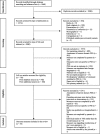Self-Report Measures of Parental Self-Efficacy: A Systematic Review of the Current Literature
- PMID: 29081640
- PMCID: PMC5646137
- DOI: 10.1007/s10826-017-0830-5
Self-Report Measures of Parental Self-Efficacy: A Systematic Review of the Current Literature
Abstract
Parenting self-efficacy (PSE) describes a parent's belief in their ability to perform the parenting role successfully. Higher levels of PSE have consistently been shown to be correlated with a wide range of parenting and child outcomes. Consequently, many parenting interventions aim to improve PSE. PSE measurement has typically been via self-report measures. However, the wide range of available measures has resulted in their limited use, inconsistent terminology and ambiguous theoretical grounding. The purpose of this systematic review was to examine the psychometric and administrative qualities of the available PSE measures and offer clarity to the terminology and the theory underpinning their use so that the future use of PSE measures can be appropriate. Eleven electronic databases were searched. Articles were included if they introduced a new measure or were psychometric evaluations of an available measure of PSE for parents of children (from infancy until 18 years of age). Thirty-four measures were identified and their psychometric and administrative qualities were examined. Overall, the quality of the available measures was varied. Whilst this review makes recommendations regarding PSE measures for parents of infants through to adolescents, some caution should be applied when choosing the most appropriate measure. The theoretical grounding of each measure was clarified so that appropriate measures can be chosen under the relevant circumstances. The implications of refinement of the available measures are discussed and further research into improving PSE measurement is identified.
Keywords: Measure; Parental; Psychometric properties; Quality.
Conflict of interest statement
The authors declare that they have no competing interests.
Figures



Similar articles
-
Parenting Self-Efficacy in Immigrant Families-A Systematic Review.Front Psychol. 2020 May 26;11:985. doi: 10.3389/fpsyg.2020.00985. eCollection 2020. Front Psychol. 2020. PMID: 32528373 Free PMC article.
-
INITIAL VALIDATION OF THE ASSESSMENT OF PARENTING TOOL: A TASK- AND DOMAIN-LEVEL MEASURE OF PARENTING SELF-EFFICACY FOR PARENTS OF INFANTS FROM BIRTH TO 24 MONTHS OF AGE.Infant Ment Health J. 2016 May;37(3):222-34. doi: 10.1002/imhj.21567. Epub 2016 Apr 19. Infant Ment Health J. 2016. PMID: 27090618
-
Predictors of parenting self-efficacy in mothers and fathers of toddlers.Child Care Health Dev. 2010 Mar;36(2):179-89. doi: 10.1111/j.1365-2214.2009.00980.x. Epub 2009 Jul 23. Child Care Health Dev. 2010. PMID: 19645829
-
The role of parental self-efficacy in parent and child well-being: A systematic review of associated outcomes.Child Care Health Dev. 2019 May;45(3):333-363. doi: 10.1111/cch.12661. Child Care Health Dev. 2019. PMID: 30870584
-
Psychometric Properties of a Scale to Assess Parental Self-Efficacy for Influencing Children's Dietary, Physical Activity, Sedentary, and Screen Time Behaviors in Disadvantaged Areas.Health Educ Behav. 2018 Feb;45(1):132-140. doi: 10.1177/1090198117699506. Epub 2017 Apr 6. Health Educ Behav. 2018. PMID: 28385099
Cited by
-
Psychometric qualities of the HLS-EU-Q16 instrument for parental health literacy in Swedish multicultural settings.BMC Public Health. 2022 Feb 12;22(1):293. doi: 10.1186/s12889-021-12346-8. BMC Public Health. 2022. PMID: 35151303 Free PMC article.
-
Association between child behavioural problems and parenting stress in autism spectrum disorders: the role of parenting self-efficacy.Int J Dev Disabil. 2022 Mar 31;70(1):49-58. doi: 10.1080/20473869.2022.2052417. eCollection 2024. Int J Dev Disabil. 2022. PMID: 38456133 Free PMC article.
-
Development of a Japanese Version of the Parenting Sense of Competence Scale, and Examining the Structure of Japanese Mothers' Parenting Self-Efficacy.Children (Basel). 2024 Nov 29;11(12):1460. doi: 10.3390/children11121460. Children (Basel). 2024. PMID: 39767889 Free PMC article.
-
Masters of Media: A longitudinal study of parental media efficacy, media monitoring, and child problematic media use across early childhood in the United States.J Child Media. 2023;17(3):318-335. doi: 10.1080/17482798.2023.2200958. Epub 2023 Apr 28. J Child Media. 2023. PMID: 37841526 Free PMC article.
-
Caregiver characteristics and behaviors: quantitative associations with child depression amongst refugees in Uganda.Glob Ment Health (Camb). 2025 Jan 30;12:e26. doi: 10.1017/gmh.2025.2. eCollection 2025. Glob Ment Health (Camb). 2025. PMID: 40070777 Free PMC article.
References
-
- Ardelt M, Eccles JS. Effects of mothers’ parental efficacy beliefs and promotive parenting strategies on inner-city youth. Journal of Family issues. 2001;22(8):944–972. doi: 10.1177/019251301022008001. - DOI
-
- Ballenski, C. B., & Cook, A. S. (1982). Mothers’ perceptions of their competence in managing selected parenting tasks. Family Relations, 489–494. http://www.jstor.org/stable/583923.
-
- Bandura A. Self-efficacy: The exercise of control. New York, NY: W.H. Freeman and Company; 1997.
-
- Bandura, A. (1988). Organizational applications of social cognitive theory. Australian Journal of Management, 13(2), 275–302.
LinkOut - more resources
Full Text Sources
Other Literature Sources
Medical
